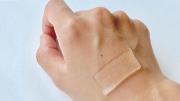Scientists at Harvard have developed a mechanically active wound dressing (the first of its kind, to the best of their knowledge), according to a paper published today—“Bioinspired mechanically active adhesive dressings to accelerate wound closure.” The researchers, led by Pinkas Family professor of bioengineering David Mooney, were inspired by fetal skin, which has the ability to actively heal wounds by contracting on itself. Traditional wound dressings treat skin injuries by passive processes, such as maintaining moisture at the wound site and protecting the wound from infection; the researchers were able instead to mimic the properties of fetal skin by using a thermoresponsive polymer that contracts in response to body heat, in effect restoring adult skin cells’ ability to pull wounds shut.
Wound management is an increasingly important concern in clinical care for several reasons, including aging populations with diminished wound-healing ability and a rising prevalence of chronic wounds such as diabetic ulcers. While other novel wound-dressing techniques have been developed to increase the efficiency of wound healing, they have usually focused on biochemical functions of wound dressings. Mooney’s team’s focused on mechanical cues, a method that has benefits such as low cost and limited side effects.
During the natural process of embryonic wound healing, actin cables are formed at the edges of cells surrounding a wound. The cables contract and draw the wound together in “a purse-string-like manner,” according to the paper. The wound dressings developed by Mooney’s team (using mice), called “active adhesive dressings,” apply similar forces when applied to adult skin. This “increases the speed and maintains the integrity of wound healing,” according to first author Serena Blacklow ’17, now a graduate student at the University of California, San Francisco.
These active adhesive dressings incorporate silver nanoparticles, commonly used in wound-care products because of their antimicrobial properties—so they are similar to passive wound dressings in that they maintain the ability to protect against infection. “If you think about a Band-Aid®, or just tape and gauze, they just sit on the wound and they protect it from the outside, but they don’t help close the wound in any way,” Blacklow explains. “This [new method] is sort of an all-in-one—it can both close the wound and protect the wound from the outside.”
Mooney and colleagues’ work differed from previous studies in wound healing in that the team controlled for the fact that loose-skinned animals, such as rodents, have wound-healing properties similar to those found in human fetal skin. “Rodent skin…has this innate property where it mechanically closes itself, kind of like fetal skin. So, if you don’t put a splint, you’re going to have this confounding factor,” Blacklow explains. “In our approach, we ensured that we controlled for this….We splinted the wound open so that all of the mechanical closing that was happening was due to our bandage, rather than any innate rodent skin closure.”
The researchers’ active dressings are also novel because they include adhesive properties, unlike other methods such as tape and gauze. The active adhesive dressings are 17 times stronger than Band-Aids®, adhering to the skin using chitosan, a fibrous sugar derived from exoskeletons of crabs and shrimp, that is sometimes used by plastic surgeons to help tissue rebuild itself.
Although the study was conducted on the external skin of mice, active adhesive dressings could have both external and internal applications in humans; the authors note in particular that the dressings may find uses in treating internal wounds to the intestines, lung, and liver. Further studies of such potential uses will be necessary, says Blacklow, but “the ideal would be, eventually, that it could be [used] for either internal or external” injuries, perhaps becoming an essential part of a surgeon’s toolkit.









